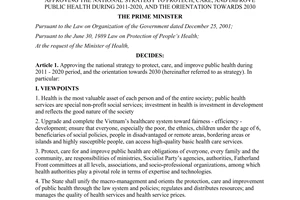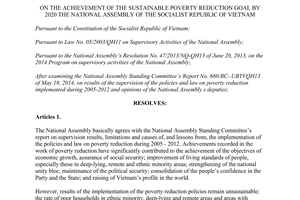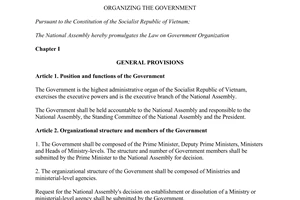Nội dung toàn văn Decision 2348/QD-TTg 2016 development of the grassroots healthcare network in the new context
|
PRIME MINISTER |
SOCIALIST
REPUBLIC OF VIETNAM |
|
No. 2348/QD-TTg |
Hanoi, December 5, 2016 |
DECISION
APPROVING THE PROGRAM FOR CONSTRUCTION AND DEVELOPMENT OF GRASSROOTS HEALTHCARE NETWORK IN THE NEW CONTEXT
THE PRIME MINISTER
Pursuant to the Law on Government Organization dated June 19, 2015;
Pursuant to the Conclusion No. 118-KL/TW dated January 4, 2016 of the Secretariat of the IXth Party’s Central Committee regarding the ongoing execution of the Resolution No. 46-NQ/TW dated February 23, 2005 of the Politburo on public health protection, care and improvement in the new context;
Pursuant to the Notice of conclusion No. 126-TB/TW dated April 1, 2013 of the Secretariat of the Party’s Central Committee regarding 10 years of implementation of the Directive No. 06-CT/TW dated January 22, 2002 of the Secretariat of the IXth Party’s Central Committee on strengthening and improvement of the grassroots healthcare network;
Pursuant to the Resolution No. 76/2014/QH13 dated June 24, 2014 of the National Assembly regarding the strengthened attainment of sustainable poverty reduction objectives till 2020;
Pursuant to the Prime Minister’s Decision No. 122/QD-TTg dated January 10, 2013 granting approval of the National Strategy for public health protection, care and improvement for the period of 2011 – 2020 with vision towards 2030;
Upon the request of the Minister of Health,
The Prime Minister issues the Decision to grant approval of the program for construction and development of the grassroots healthcare network in the new context.
HEREBY DECIDES
Article 1. Approving the program for construction and development of the grassroots healthcare network in the new context, including the following main contents:
I. OBJECTIVES
1. Reform the personnel structure, the operational machinery and the financial system, and develop human resources, in order to increase the healthcare service capacity and the quality of healthcare services provided by the grassroots healthcare network; ensure that primary care, health examination and treatment services are fully provided for local inhabitants, and medical services are rendered in a comprehensive, continuous and coordinative manner, and prophylactic and therapeutic services at localities and lower levels are integrated with those at other localities and higher levels; contribute to holding down patient overload in higher-level hospitals; assure equality and effectiveness in public health protection, care and improvement.
2. By 2020, at least 90% of commune-level healthcare stations is expected to meet regulatory eligibility requirements for provision of medical services within health insurance coverage and be capable of rendering at least 80% of technical medical services mentioned in the list of commune-level technical medical services; 95% of district-level healthcare stations is expected to have competence in rendering at least 80% of technical medical services mentioned in the list of district-level technical medical services; 70% of communes will satisfy national commune-level healthcare criteria; 90% of population will be accessible to health management and monitoring services; investments in healthcare stations of communes facing economic difficulty or extreme economic difficulty will be completed;
3. By 2025, 100% of commune-level healthcare stations is expected to meet regulatory eligibility requirements for provision of medical services within health insurance coverage and be capable of rendering all primary care services and at least 90% of technical medical services mentioned in the list of commune-level technical medical services; 100% of district-level healthcare stations is expected to have competence in carrying out at least 90% of technical medical services mentioned in the list of district-level technical medical services; 100% of communes is expected to satisfy national commune-level healthcare criteria; 100% of population will be accessible to health management and monitoring services.
II. SCOPE AND PERIOD OF IMPLEMENTATION OF THE PROGRAM
1. Scope: Grassroots healthcare shall include healthcare at the urban district, rural district, town, provincial city, commune, townlet and village levels.
2. Program implementation period: The program lasts from 2016 to 2025.
III. MISSIONS AND SOLUTIONS FOR IMPLEMENTATION OF THE PROGRAM
1. Strengthen and improve the organizational structure of the grassroots healthcare network.
a) Organize uniform models of medical centers in urban/rural districts, towns or provincial cities (hereinafter referred to as district-level healthcare center) that are capable of fully carrying out prophylactic, medical examination, treatment and functional rehabilitation services; use uniform models of regional clinics and maternity wards (if any) and medical stations at communes, wards or townlets (hereinafter referred to as commune-level healthcare station) located within districts as specialized units put under the control of district-level healthcare centers. The number of medical staff working at commune-level healthcare stations on the payroll of district-level healthcare centers shall be determined, depending on their work positions, to ensure the number of medical staff will meet the needs of specific positions and actual conditions of specific localities in respective nationwide regions.
b) Classify healthcare stations according to the set of national commune-level healthcare criteria in order to establish the appropriate operational and investment mechanism.
2. Renovate and increase effectiveness in grassroots healthcare activities.
a) Commune-level healthcare stations must fulfill their assigned duties to provide primary care services; to render such services as comprehensive and ongoing management of health of local residents with emphasis on health monitoring and consultancy; palliative care; functional rehabilitation; elderly, maternity and child care; prevention and control of communicable or non-communicable diseases, management of chronic diseases; medical examination and treatment services provided within their assigned duties and delegated powers; and connection and referral of patients to higher-level healthcare establishments.
b) District-level healthcare centers must continue to improve their professional competence and promote healthcare services and technologies, including medical test, subclinical services, with the aim of ensuring convenience and relevance to serve the needs of general medical treatment and basic care, and must regularly give directions, direct professional support and build close medical connections with other district-level healthcare centers and other commune-level healthcare stations.
c) Design and implement the mechanism for cooperation between public healthcare establishments and non-public ones within local jurisdictions, and provide incentive policies so as to encourage private participation in the primary care sector.
d) Digitize grassroots healthcare activities and management of health records of each resident. Synchronize and connect communication systems of commune-level healthcare stations and those of district-level healthcare centers to monitor and manage health of residents within local jurisdictions under their assigned duties; design and develop electronic medical records; manage medical examination, treatment services and medical costs covered by the health insurance plan at commune-level or district-level healthcare establishments.
dd) District-level, commune-level and village-level healthcare establishments shall have to get actively involved in communication and visibility campaigns to raise and change public awareness and behaviors to protect and increase health, and enthusiastically participate in prophylactic and primary health care services.
3. Strengthen training and improve the quality of human resources
a) Continue to increase human resources, especially the number of physicians working at district-level healthcare centers, in order to provide adequate staff to meet local people's needs for medical services; fully staff commune-level healthcare stations to provide primary care and health monitoring services for the public.
b) Continue to train medical workforce in every form to meet human resource demands of grassroots healthcare establishments; pay attention to provide training with appropriate academic programs and terms for clinicians working at commune-level healthcare stations; train more medical staff working at village-level healthcare establishments and midwives working at villages within poor or very poor regions. Provide more training programs and carry out more technology transfers and ensure full compliance with regulations on ongoing education, practice-based education and professional instructions for grassroots healthcare establishments.
c) Carry out the two-way staff rotation system corresponding to local conditions, including descending and ascending rotation methods, for the purposes of increasing capabilities of licensed physicians working at grassroots healthcare establishments.
4. Reform the financial mechanism for grassroots healthcare operations
a) Accelerate the universal insurance schedule, grant increased subsidies to persons living in near-poor families, or persons working in the agriculture, forestry, fishery and salt production sectors with average standards of living to ensure they have access to health insurance plans. Commune-level healthcare stations shall be responsible for participating in communication and visibility campaigns for public participation in health insurance programs according to instructions of the Ministry of Health and Social Security of Vietnam.
b) Revise the list of technical medical services, the list of medicines funded by health insurance covers at commune-level and district-level healthcare stations in order to increase access to medical services provided by grassroots healthcare establishments to holders of health insurance cards.
c) Design and issue price levels and systems for payment of health insurance covers applied to patients receiving medical services provided by family physician clinics; particular or special patients receiving home health care services; patients receiving health examination and consultancy services; health insurance card holders receiving home-based physical examination and midwifery services, clean birth midwifery service packages rendered in several particular cases at mountainous, remote and isolated areas; mobile medical services of commune-level healthcare stations, district-level healthcare centers and hospital that reach villages on a periodical basis; common medicines dispensed to fishermen working ashore; etc. in order to increase access to medical services for people living at mountainous, remote, isolated, poor, boundary, sea or island areas.
d) Design basic healthcare service packages provided by grassroots healthcare networks in order to meet health care demands of the public. Each package must distinguish which service components must be covered by the Health Insurance Fund. Make payments to outpatients receiving grassroots healthcare services according to the capitation method.
dd) Carry out the price schedule of medical services with a view to calculating sufficient grassroots healthcare costs. Classify and grant autonomy to district-level healthcare centers. The state budget funding shall be given to those district-level healthcare centers classified by competent regulatory authorities as partially financial self-regulatory units and state-funded units.
e) Review, revise and release limits on state budget expenditures on district-level preventive healthcare establishments which fit with respective areas, regions and geographical conditions, illness models, and ensure adequacy of salaries, wages and other compensation packages paid to grassroots medical staff, allowances paid to medical staff working at villages; decide on and issue rates of regular spending in addition to salaries or wages to guarantee the sufficient budget for regular activities and primary health care services of commune-level healthcare stations. Robustly reform the method for allocating funds of the state budget and the Health Insurance Fund and other resources to grassroots healthcare establishments with a view to adopting performance and output as influencing factors of such method.
g) Formulate and issue incentive policies and tighten ties between private healthcare establishments and public ones with respect to supply of primary health care services at localities. Allow commune-level healthcare stations to cooperate with private healthcare establishments to provide medical services to the public.
5. Making ongoing investments in order to improve and increase capacity of the grassroots healthcare system.
a) District-level healthcare establishments: Provinces and centrally-affiliated cities may use central government’s funds (if any), local government’s funds and other legal capital for continuously investing in complete grassroots healthcare systems with priority given to healthcare centers located within newly-split poor districts, or districts enjoying policies applied to poor districts; island districts; districts without district-level healthcare centers or with district-level healthcare centers that have already been degraded to the extent that they are incapable of providing medical services to the public.
b) Commune-level healthcare stations: During the period from now to 2020, the central budget and local budgets must concentrate their funds on investing in commune-level healthcare stations according to the following principles:
- Communes facing extreme socio-economic difficulty, boundary communes and safe zone communes; coastal communes; communes located within poor areas, all of which are subject to the Prime Minister’s Decisions (the central budget shall reduce funds invested in healthcare stations of communes or wards near healthcare centers of urban/rural districts, towns or provincial-level hospitals; in addition, facilities of commune-level healthcare stations shall be effectively exploited).
- Newly split or established communes that do not have healthcare stations, communes using healthcare stations of others, communes having healthcare stations ruined by natural disasters or catastrophic events; communes having temporary, seriously collapsed, damaged or degraded healthcare stations that need to be demolished and replaced by new ones, altered or refurbished;
Construction of new healthcare stations, alteration, expansion or refurbishment of existing ones must be based on construction designs, demands and actual conditions of localities, and ensure cost efficiency and avoidance of any waste.
c) Investment capital
- Local budget: Provinces and centrally-affiliated cities shall prefer allocating their local budgets and other legal funding sources to investment in grassroots healthcare establishments.
- Funds of the National Target Program for Construction of New Rural Areas and other target programs funded by the central budget; ODA grants, shall be used for investing in the grassroots healthcare sector.
- Annual state budget funds for the public healthcare sector per capita: Based on the practical conditions, implement the schedule for adjustment to medical service prices, provinces and centrally-affiliated cities may use part of funds currently allocated to hospitals for building new healthcare facilities, renovating, maintaining and repairing, and supply of equipment to, existing healthcare establishments.
- 20% of residual surplus amounts in the Health Insurance Fund under laws on health insurance (accruing from January 1, 2015 to December 31, 2020, if any) may be used for investment in grassroots healthcare systems.
Article 2. Implementation responsibilities
1. Ministry of Health
a) Preside over formulating and completing professional procedures and undertake assessments of quality of grassroots healthcare services.
b) Take charge of and collaborate with other Ministries and related entities in formulating and appealing the Government and the Prime Minister to issue, or issuing within their jurisdiction, policies in order to reform the operational, financial and investment mechanisms for the grassroots healthcare sector and the mechanism for using capital of the health insurance fund for grassroots healthcare and primary care services.
c) Draw up plans to raise and use ODA grants and other resources to invest in building, upgrading and renovating medical facilities or premises, supplying equipment and training employees working in the grassroots healthcare network.
dd) Preside over and collaborate with other Ministries and related sectoral administrations in carrying out inspections and assessments of the progress of implementation of this Program at localities, and periodically submit annual review reports, including recommended solutions to dealing with issues and difficulties, to the Prime Minister.
2. Ministry of Finance and Ministry of Planning and Investment shall be responsible for presiding over and collaborating with the Ministry of Health and the Social Security of Vietnam in formulating policies and regimes for health insurance growth and assurance of grassroots healthcare resources required by laws.
3. Ministry of Agriculture and Rural Development: Cooperate with the Ministry of Health in integrating investments in commune-level healthcare stations into the National Target Program for Construction of New Rural Areas and allocating annual funds of such Program for implementation of this Program.
4. Social Security of Vietnam:
a) Preside over and cooperate with the Ministry of Health and localities in strengthening public communication and visibility campaigns to encourage people to participate in the health insurance plan.
b) Review and promote administrative reforms; revise within their jurisdiction, or request authorized entities to revise, regulations in order to expand health insurance coverage and protect legitimate rights and interests of health insurance policyholders.
c) Cooperate with the Ministry of Health and the Ministry of Finance in designing and carrying out mechanisms for use of the health insurance fund for grassroots healthcare and primary care services.
5. People’s Committees of centrally-affiliated cities and provinces:
a) Develop plans and carry out this Program at localities under their jurisdiction. Allocate local budget's funds (spent on investment and other public affairs) for this Program with priority given to funds from the National Target Program on Construction of New Rural Areas, the National Target Program on Sustainable Poverty Reduction, the National Target Program on Investment in Development of Local Healthcare System and the Target Health – Population Program, and mobilize other legal capital for implementation of this Program.
b) Provide adequate human and financial resources available for grassroots healthcare activities; formulate and issue incentive or allowance policies to attract physicians working for grassroots healthcare establishments.
c) Head inspections and assessments of the progress of this Program while being carried out at localities, periodically send the Ministry of Health annual reports for the purposes of compiling general reports on results of implementation of this Program and give recommended solutions to dealing with difficulty and issues.
Article 3. This Decision shall enter into force from the signature date.
Article 4. Ministers, Heads of Ministry-level agencies, Heads of Governmental bodies, and Chairpersons of People’s Committees of centrally-affiliated cities and provinces, shall be responsible for implementing this Decision./.
|
|
PP. PRIME
MINISTER |
------------------------------------------------------------------------------------------------------
This translation is made by THƯ VIỆN PHÁP LUẬT and
for reference purposes only. Its copyright is owned by THƯ VIỆN PHÁP LUẬT
and protected under Clause 2, Article 14 of the Law on Intellectual Property.Your comments are always welcomed



